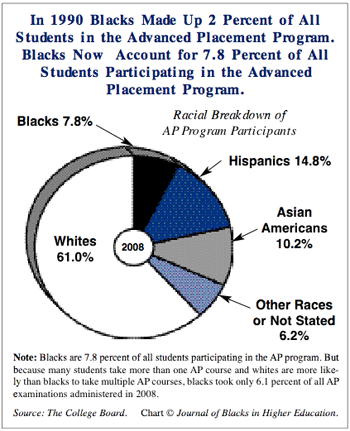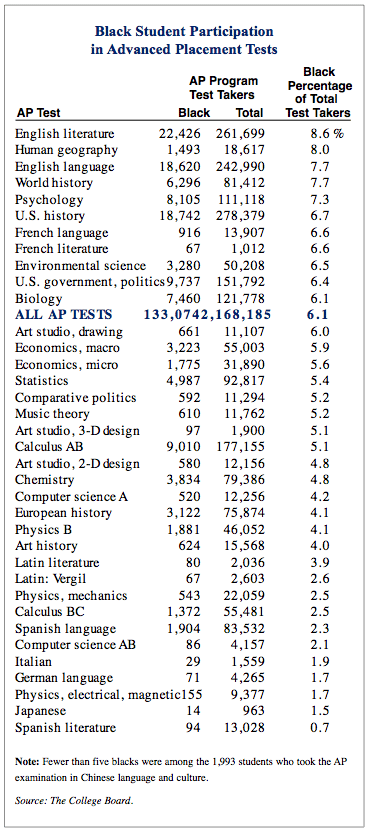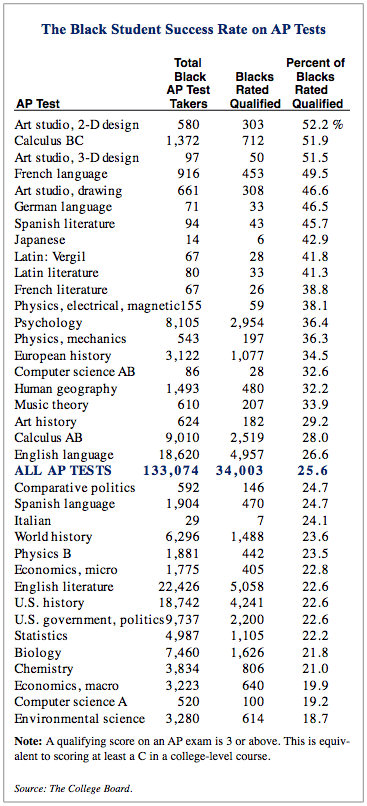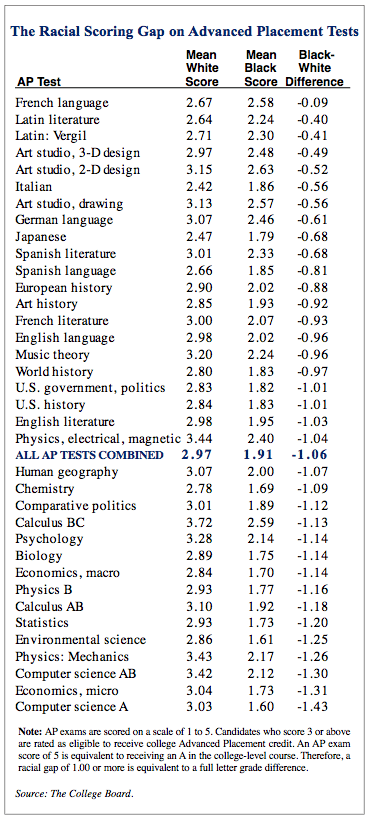| More Blacks Are Competing in Advanced Placement Programs, But the Racial Scoring Gap Is Widening The number of blacks taking academically challenging Advanced Placement courses in high school has surged. The bad news is that the racial scoring gap on Advanced Placement tests continues to be large and in fact has increased in recent years.
Important, too, is that many colleges and universities in the United States give college course credits to college-bound students who have received a high score on AP exams. Countering the huge and escalating costs of higher education, AP credits may enable black students to graduate a full semester early. This produces solid savings in the overall costs of earning a college degree. Thus, in addition to leading to the admission of more blacks to stronger academic institutions, the AP test opportunity is important for African-American college students who, because of huge racial wealth and income inequalities, are likely to be at a distinct disadvantage compared to whites in their ability to pay for college. Here is some further background on the history of the Advanced Placement program. In 1952 the Ford Foundation noticed that the very brightest high school students were studying precisely the same material as students in many entry-level college courses. As a result, the foundation developed the concept of advanced placement. Through its Fund for the Advancement of Education, the Ford Foundation began to produce an AP curriculum. In the fall of 1954, when The College Board assumed control of the AP program, seven pilot high schools in cooperation with 12 participating colleges began offering Advanced Placement classes. Today, AP courses are offered at more than 16,400 of the nation’s high schools. Curriculum and course outlines are developed for The College Board by college faculty members after an elaborate process of surveying the content of courses in similar subjects at more than 200 colleges nationwide. Course descriptions, teacher guides, publications, and online teleconferences are made available by The College Board to high school teachers to help them prepare their students for the AP examinations. More than a half-century ago, in 1956, the first AP exams in 10 separate academic disciplines were administered by The College Board. That year about 1,000 students took approximately 2,000 AP tests. (High school students may take any number of AP exams in different subjects.) In 2008, 757,932 American students took more than 2.1 million AP exams in 37 different subjects. The College Board validates the results of its exams by giving the same tests to a selection of college students who are taking similar courses. The College Board then compares the grades received by the college students to the results achieved by the AP high school students. AP exams are graded on a scale of 1 to 5. A score of 5 on the AP exam is equivalent to receiving a grade of A in a similar college course. An AP test score of 4 is equivalent to a college grade of B and so on down the line. Students scoring 3 or above on the AP test are deemed qualified to receive college credit.
Major Rise in Black Participation in the AP Program
Over the next five years the number of blacks enrolled in AP courses more than quadrupled. In 1997 blacks took 34,514 AP exams, up more than fivefold from 1990. By 2008 the number of AP exams taken by black students had jumped to 133,074, nearly 20 times as many exams that were taken by black students in 1990. The number of AP examinations taken by blacks was up nearly 18 percent in 2008 over the previous year. This is on top of a 20 percent increase from 2006 to 2007. In 2008 there were 58,872 black students who participated in the AP program, an increase of more than 14 percent from 2007. In 2008 each black student took, on average, 1.9 AP tests. The good news is that in 2008 blacks took 6.1 percent of all AP examinations administered in the United States, up from 4.6 percent in 2003 and 5.8 percent in 2007. But despite this major progress, blacks still lag far behind whites in participation in the AP program. The AP shortfall is revealed in the fact that blacks now make up 11 percent of all SAT test takers and more than 14 percent of all high school students in the nation.
Barriers to African-American Participation Traditionally, most participants in the AP program have been concentrated in high schools in affluent, predominantly white suburbs of major cities. Also, in many racially integrated high schools, large numbers of black students have not been sufficiently prepared to take on the AP curriculum. In many instances black students have been tracked into vocational training instead of college preparatory classes. Unfortunately, many teachers, guidance counselors, and school administrators continue to hold a racist mindset that black students are not capable of coping with the rigorous curriculum of the AP program. Influenced for many years by widespread opinion that they have substandard academic abilities, black students in many instances do not consider enrolling in the AP program. Also, at some schools black students who might wish to pursue an AP curriculum may face anti-intellectual peer pressure that makes young blacks feel that in pursuing Advanced Placement they are selling out their race or “acting white.” Another barrier to black participation in the AP program is the $86 fee for taking an exam in each subject area. A student looking to gain significant college credits may be forced to pay $400 or more to take the necessary AP tests. The College Board does offer a $22 fee reduction for needy students. However, even a lower exam fee may put the cost of the tests out of reach for many black families. Several states offer additional financial aid for Advanced Placement students.
Comparing Black and White Participation in the Advanced Placement Program For both blacks and whites, English literature, American history, and English language were the most popular AP courses. Blacks were 8.6 percent of all students who took the AP test in English literature. This was the highest participation percentage for blacks on any of the 37 AP tests. Blacks were also at least 7 percent of all test takers in the subject areas of English language, human geography, psychology, and world history. The lowest level of black participation occurred in the Spanish literature test. Only 94 black students nationwide took the AP test in Spanish literature in 2008. They were just 0.7 percent of all test takers in this subject. Blacks were also less than 2 percent of all AP test takers in the subject areas of electrical and magnetic physics, Italian, German, and Japanese. Recent increases in black participation in the AP program is encouraging. But even better news is that of the 133,074 AP exams taken by black students in 2008, qualifying grades were received on 34,003 tests. It is encouraging too that a much larger number of black high school students are achieving success in college-level courses. However, black students’ performance on AP tests still remains far below that of white students. And with a greater pool of black students taking AP examinations in recent years, the racial scoring gap on AP tests has increased.
Racial Comparisons in Advanced Placement Scores Nationwide, the mean AP score for white students is 2.97; for blacks it is 1.91. This means that the average black score is a full letter grade below the average white score. This gap has widened slightly in the past several years. In 2008, of the 1,313,326 AP exams taken by white students, a qualifying grade of 3 or above was achieved on 62.5 percent of the tests. Blacks received qualifying grades of 3 or above on only 25.6 percent of the AP exams that they took. Thus, whites were more than twice as likely as blacks to receive a qualifying grade. Over the past four years, as the number of black test takers has increased, the percentage of all black test takers receiving qualifying grades dropped from 29.2 percent to 25.6 percent. However, there was a slight overall increase in 2008. At the very highest level of AP test scores, the black-white scoring gap is even greater. Some 14.1 percent of white test takers received a score of 5, equivalent to a college grade of A. Only 2.8 percent of black test takers received a score of 5. Blacks, who as we stated earlier took 6.1 percent of all AP tests, made up only 2.7 percent of all students who became eligible for college credit and only 1.3 percent of all students with the highest score of 5.
Black Performance on Advanced Placement Tests In order to gauge black student success on AP exams, we constructed two tables. First, we compared the total number of black test takers to the number of blacks who received a qualifying grade of 3 or above. Nationwide, as stated earlier, 25.6 percent of all black test takers received a grade of 3 or above. But there was a wide discrepancy in this success ratio for black students on the different subject tests. Blacks had their greatest success rates on two of the three art tests. More than half of all black test takers received a score of 3 or higher on these two tests. It is encouraging to report that one of the AP courses in which blacks achieved the most success was one of the two calculus tests. Nearly 52 percent of all black students who took this AP exam received a score of 3 or above. But more than 80 percent of all white students who took this AP calculus examination received a qualifying grade. On the studio art drawing AP test, 46.6 percent of black students received a qualifying grade. This is the only AP course where there is no examination. Students are graded by an assessment of their drawing portfolios. More than 71 percent of white students received a grade of 3 or above on their drawing portfolio. At the other end of the performance spectrum, only 614 of the 3,280 black students, or 18.7 percent, who took the AP environmental science test received a qualifying score of 3 or above. Less than 25 percent of all black students succeeded in qualifying for college credit in the subject areas of macroeconomics, physics, statistics, U.S. history, English literature, U.S. government and politics, chemistry, microeconomics, Spanish, world history, Italian, comparative politics, and the more widely taken of the two computer science tests.
The Black-White Scoring Gap on AP Test Another way of rating black student performance on AP exams is to compare black scores to white students’ scores on the various subject tests. Overall, the mean score for whites on all AP tests was 2.97. As stated, the mean score for blacks on all AP tests was 1.06 points lower at 1.91. This is the equivalent of more than a full letter grade in a college course. The largest black-white scoring gap was on one of the two computer science tests. On that exam, the mean white score of 3.03 was 1.43 points higher than the mean black score of 1.60. The black-white scoring gap was also at least 1.00 point (equivalent to a full letter grade in a corresponding college level course) on 18 other AP examinations. The mean black score on the French language test was 2.58 compared to the mean white score of 2.67. This was the only AP examination where the mean black score was close to the mean score for whites. On AP tests in foreign languages, blacks, compared to whites, generally do much better than they do on most other AP exams. There are several possible explanations. One explanation for black students’ success on the French AP test may be that there are large groups of African-American students with a heritage from islands in the French West Indies, West Africa, or French-speaking areas of Louisiana. Similarly, black students whose parents emigrated from Cuba or the Dominican Republic may have a firm background in the Spanish language. However, neither of these possibilities would explain the relative success of black students on the German, Italian, Japanese, or Latin AP exams. We suggest that in foreign languages students of all races tend to enter their studies with little or no head start and with very little or no rudimentary knowledge of the subject matter. Unlike the study of math or reading, factors such as cultural biases, preschool and elementary school activities, parental reading habits, ownership of a home computer, etc., have less effect at the starting gate in the study of a foreign language. This would explain at least in part why black and white students score at relatively similar levels on tests in foreign language subjects. It is good news that blacks are increasingly taking on the challenges of the Advanced Placement program. But, as is the case on other standardized tests, the AP test results show that black students are not as well prepared as white students for these tests. In fact, as increasing numbers of black students enter the AP test-taking pool, it may be expected that the racial gap in AP test scores will increase in the years ahead.
|
|




 Over the past 20 years there has been a solid increase in the number of black students who are taking challenging Advanced Placement courses in high school. College admissions officers are impressed with the records of students who make the extra effort and take the grading risk in AP courses. Now, with a transcript in hand that shows a student has faced up to these rigorous programs of study, admissions officers often confer a deserved advantage in the admissions process to students of all races who enroll in AP programs.
Over the past 20 years there has been a solid increase in the number of black students who are taking challenging Advanced Placement courses in high school. College admissions officers are impressed with the records of students who make the extra effort and take the grading risk in AP courses. Now, with a transcript in hand that shows a student has faced up to these rigorous programs of study, admissions officers often confer a deserved advantage in the admissions process to students of all races who enroll in AP programs.  Over the past two decades there has been a huge increase in the number of black students who are taking challenging Advanced Placement courses in high school. In 1985 there were only 2,768 black students taking Advanced Placement courses in the United States. At that time blacks made up just one percent of the more than 270,000 AP students. By 1990 black participation in AP programs had more than doubled. That year black students took some 6,800 AP exams.
Over the past two decades there has been a huge increase in the number of black students who are taking challenging Advanced Placement courses in high school. In 1985 there were only 2,768 black students taking Advanced Placement courses in the United States. At that time blacks made up just one percent of the more than 270,000 AP students. By 1990 black participation in AP programs had more than doubled. That year black students took some 6,800 AP exams. 

